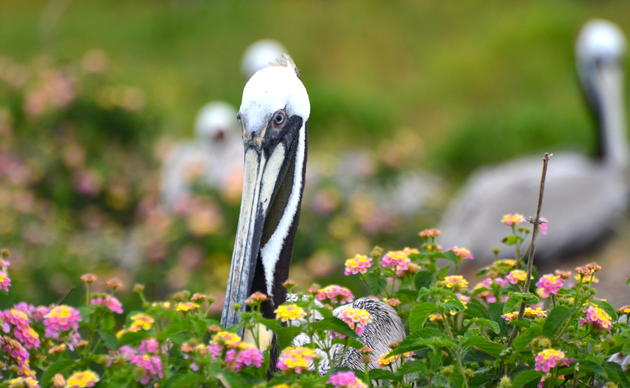Little Blue Heron
Little blue herons are unique in the heron family; they are the only species in which juvenile and adult coloration differs substantially. Juvenile Little Blue Herons are completely white, while adults are a smoky blue-grey.
The Little Blue Heron nests in mixed species rookeries of colonial waterbirds in a variety of habitat types and nesting structures. The species can be found using a variety of freshwater and marine habitats for both nesting and foraging. Foraging sites are generally shallow, 5-15 cm deep, and can average between 2.9 km and 10.2 km from the colony. Nesting substrate and location are extremely varied, suggesting that neither plant species or the site are as important as the availability of stable plant species for adequate nest support, an absence of predators and access to nearby foraging habitat and resources. Nests are regularly located in lower shrubs, bushes and small trees, below the canopy in less accessible, protected sites.
For more information on Little Blue Herons, including identification tips, visit their page on the Cornell Lab of Ornithology.
Text References
- Rodgers, J. J. A. and H. T. Smith. 1995b. Little Blue Heron (Egretta caerulea).in A. Poole, editor. The Birds of North America Online Cornell Lab of Ornithology, Ithaca.
- Willard, D. E. 1977. The feeding ecology and behavior of five species of herons in southeastern New Jersey. Condor 79:462-470.
- Custer, T. W. and R. G. Osborn. 1978. Feeding habitat use by colonially breeding herons, egrets, and ibises in North Carolina. Auk 95:733-743.
- Bancroft, G. T., S. D. Jewell, and A. M. Strong. 1990. Foraging and nesting ecology of herons in the lower Everglades relative to water conditions. Final rep. to South Florida Water Manage. District, West Palm Beach.
- Rodgers, J., J. A. and H. T. Smith. 1995a. Little Blue Heron (~Egretta caerulea~).in A. Poole and F. Gill, editors. The birds of North America, no. 145. Acad. Nat. Sci., Philadelphia, and Am. Ornithol. Union, Washington, D.C.
How you can help, right now
Join Audubon Texas Today
Becoming a member supports our local work protecting birds and the places they need.
Consider a Legacy Gift for Texas
Planned gifts and bequests allow you to provide a lasting form of support to Audubon Texas.
Subscribe to Our Newsletter
Subscribe to our newsletter for updates about Audubon Texas's conservation work, and news about our activities and local events.




